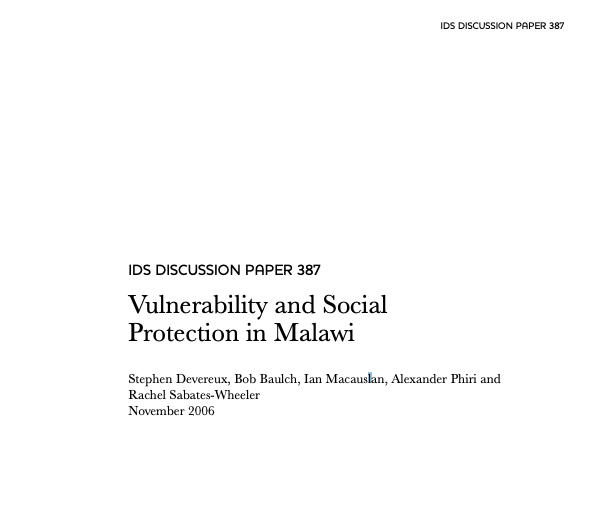Vulnerability and Social Protection in Malawi

Vulnerability appears to be rising for many Malawians, whose exposure to livelihood shocks is increasing while their ability to cope is decreasing. The first part of this report draws on recently published studies and analysis of the 2004/05 Integrated Household Survey dataset to explore the nature of vulnerability in Malawi. Most livelihoods in Malawi depend on agriculture, but agricultural vulnerability is extremely high due to erratic rainfall, inequality in landholdings, constrained access to inputs, limited diversification and weak markets. Noneconomic factors that compound economic risks include demographic and health risks, gendered vulnerabilities, social change and governance failures.
Economic vulnerability, defined as the risk of future monetary poverty, is high because of the heavy concentration of Malawians clustered close to the poverty line, and because of the frequency and severity of covariant shocks such as droughts, floods and food price fluctuations, as well as idiosyncratic shocks such as accidents, illness and death of family members. The economic, demographic and social impacts of HIV/AIDS are especially devastating. Monetary and subjective indicators of vulnerability are related to demographic characteristics (female- and older-headed households, orphans), lack of assets, geographic location (with a north-south gradient of rising vulnerability) and multiple shocks. Policy priorities derived from this analysis include: stabilise food prices, enhance access to agricultural inputs, and identify labour-saving technologies for labour-constrained households. More generally, social protection and livelihood promotion measures, together with an enabling environment, are central to addressing vulnerability in Malawi.
The second part of this report reviews a range of ongoing and discontinued social protection mechanisms in Malawi. Free inputs distribution (‘Starter Packs’) followed the abolition of fertiliser subsidies in the 1990s, and had positive impacts on food production and prices. Public works programmes (food-, cash- or inputs-for-work), social funds (the Malawi Social Action Fund) and food transfers (food aid, school feeding) also have long histories in Malawi, but have demonstrated limited impacts. Finally, unconditional cash transfers are increasingly popular, which this review endorses with the qualification that ongoing pilot projects need to be institutionalised within a comprehensive, government owned, national social protection strategy.